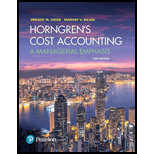
Relevant costs, opportunity costs. Gavin Martin, the general manager of Oregano Software, must decide when to release the new version of Oregano’s spreadsheet package, Easyspread 2.0. Development of Easyspread 2.0 is complete; however, the diskettes, compact discs, and user manuals have not yet been produced. The product can be shipped starting July 1, 2017.
The major problem is that Oregano has overstocked the previous version of its spreadsheet package, Easyspread 1.0. Martin knows that once Easyspread 2.0 is introduced, Oregano will not be able to sell any more units of Easyspread 1.0. Rather than just throwing away the inventory of Easyspread 1.0, Martin is wondering if it might be better to continue to sell Easyspread 1.0 for the next three months and introduce Easyspread 2.0 on October 1, 2017, when the inventory of Easyspread 1.0 will be sold out.
The following information is available:
| Easyspread 1.0 | Easyspread 2.0 | |
| Selling price | $165 | $215 |
| Variable cost per unit of diskettes, compact discs, user manuals | 24 | 38 |
| Development cost per unit | 60 | 95 |
| Marketing and administrative cost per unit | 31 | 41 |
| Total cost per unit | 115 | 174 |
| Operating income per unit | $ 50 | $ 41 |
Development cost per unit for each product equals the total costs of developing the software product divided by the anticipated unit sales over the life of the product. Marketing and administrative costs are fixed costs in 2017, incurred to support all marketing and administrative activities of Oregano Software. Marketing and administrative costs are allocated to products on the basis of the budgeted revenues of each product. The preceding unit costs assume Easyspread 2.0 will be introduced on October 1, 2017.
- 1. On the basis of financial considerations alone, should Martin introduce Easyspread 2.0 on July 1, 2017, or wait until October 1, 2017? Show your calculations, clearly identifying relevant and irrelevant revenues and costs.
Required
- 2. What other factors might Gavin Martin consider in making a decision?
Want to see the full answer?
Check out a sample textbook solution
Chapter 11 Solutions
Horngren's Cost Accounting, Student Value Edition Plus MyLab Accounting with Pearson eText - Access Card Package (16th Edition)
- hello tutor provide correct answer general accountingarrow_forwardNonearrow_forwardThe second step, when using dollar-value LIFO retail method for inventory, is to determine the estimated: Multiple Choice Cost of goods sold for the current year. Ending inventory at cost. Ending inventory at current year retail prices. Ending inventory at base year retail prices.arrow_forward
- Data related to the inventories of Kimzey Medical Supply are presented below: Surgical Equipment Surgical Supplies Rehab Equipment Rehab Supplies Selling price $ 315 $ 175 $ 395 $ 220 Cost 225 145 305 217 Replacement cost 295 135 290 213 Costs to sell 52 16 36 32 Normal gross profit ratio 40% 40% 40% 40% In applying the lower of cost or market rule, the inventory of surgical supplies would be valued at: Multiple Choice $155. $145. $135. $119.arrow_forwardData related to the inventories of Alpine Ski Equipment and Supplies is presented below: Skis Boots Apparel Supplies Selling price $ 168,000 $ 163,000 $ 109,000 $ 66,000 Cost 140,000 142,000 70,850 42,900 Replacement cost 131,000 128,000 90,850 38,900 Sales commission 10% 10% 10% 10% In applying the lower of cost or net realizable value rule, the inventory of skis would be valued at: Multiple Choice $151,200. $131,000. $140,000. $117,600.arrow_forwardHow much is reggies amount realized?arrow_forward
 Essentials of Business Analytics (MindTap Course ...StatisticsISBN:9781305627734Author:Jeffrey D. Camm, James J. Cochran, Michael J. Fry, Jeffrey W. Ohlmann, David R. AndersonPublisher:Cengage Learning
Essentials of Business Analytics (MindTap Course ...StatisticsISBN:9781305627734Author:Jeffrey D. Camm, James J. Cochran, Michael J. Fry, Jeffrey W. Ohlmann, David R. AndersonPublisher:Cengage Learning Cornerstones of Cost Management (Cornerstones Ser...AccountingISBN:9781305970663Author:Don R. Hansen, Maryanne M. MowenPublisher:Cengage Learning
Cornerstones of Cost Management (Cornerstones Ser...AccountingISBN:9781305970663Author:Don R. Hansen, Maryanne M. MowenPublisher:Cengage Learning

